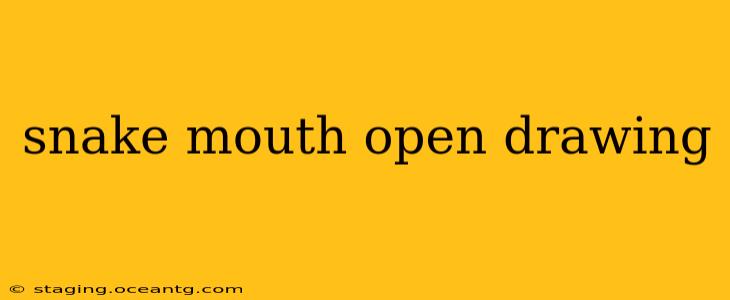Drawing a snake with its mouth open presents a unique challenge, requiring careful attention to anatomy, perspective, and the desired expression. Whether you're aiming for a menacing viper or a curious garter snake, this guide will help you master the art of depicting a realistically opened snake mouth.
What Makes a Snake's Open Mouth Unique?
Unlike mammals, a snake's jaw is incredibly flexible and dislocatable. This allows them to swallow prey significantly larger than their head. This unique feature must be considered when drawing an open mouth. The lack of external ears and the positioning of the eyes also influence the overall look. Understanding these anatomical differences is key to creating a convincing image.
How to Draw a Snake's Open Mouth: A Step-by-Step Guide
-
Sketch the basic shape: Begin with a simple outline of the head and the general shape of the open mouth. Think about the overall posture of the snake – is it striking, defensively open, or simply yawning? This will heavily influence the angle and shape of the mouth.
-
Define the jaw structure: Snakes have two distinct jawbones, the upper and lower. The lower jaw is more mobile and can stretch considerably. Carefully sketch these, paying attention to how they articulate and how much they are separated.
-
Add the fangs (if applicable): Many snakes possess venomous fangs. These are typically located in the maxilla (upper jaw) and are often retractable. Research the specific type of snake you're drawing to accurately depict the fang placement and size. Pay attention to the curvature and sharpness of the fangs.
-
Detail the mouth's interior: Snakes' mouths are lined with numerous small teeth, which are often difficult to see unless the mouth is significantly open. You may want to subtly suggest the presence of teeth through a textured line or a few strategically placed individual teeth.
-
Add the tongue: The forked tongue of a snake is a vital sensory organ. Its characteristic shape should be included, extending from the opening of the mouth. Consider the tongue's position relative to the open jaws – is it extended, retracted, or somewhere in between?
-
Refine the details: Once the basic structure is complete, refine the details. Consider adding texture to the scales around the mouth, and subtle shading to give it depth and realism.
-
Express the emotion: The position of the jaw, the tension in the muscles, and the eyes all contribute to expressing the snake’s emotional state. A wide, gaping mouth can depict aggression, fear, or even hunger, while a slightly open mouth might show curiosity or alertness.
What are some common mistakes to avoid when drawing a snake's open mouth?
- Symmetrical jaws: Snake jaws are rarely perfectly symmetrical when open.
- Ignoring the flexibility: The extreme flexibility of the jaw is often overlooked, resulting in unrealistic depictions.
- Inaccurate fang placement: Fangs are a crucial detail, and their incorrect placement can significantly detract from the overall accuracy.
- Overlooking the tongue: The tongue plays a vital role in a snake's appearance and should not be ignored.
How do I draw different types of snake mouths open?
The approach to drawing an open snake mouth varies depending on the snake species. Cobras, for example, have a distinct hood that expands when their mouths are open, while vipers have longer, more prominent fangs. Researching the specific snake's anatomy is crucial for accurate representation.
What materials are best for drawing snake mouths?
Pencils, charcoal, and even digital tools can all be effectively used. The choice depends on personal preference and the desired level of detail. Using different pencil grades to create shading and highlight details adds realism.
By carefully observing snake anatomy, practicing the steps outlined above, and understanding the unique characteristics of different species, you can confidently draw a realistic and expressive snake with its mouth open. Remember to study references – photographs and videos of snakes are invaluable resources.
